Marriott Case Analysis: Strategic Planning and Management Report
VerifiedAdded on 2022/11/07
|9
|1753
|228
Case Study
AI Summary
This case study analyzes Marriott International, examining its challenges and opportunities within the hospitality industry. The analysis begins by identifying key issues, such as competition from online travel agencies and home-sharing platforms, alongside opportunities like loyalty programs and innovation. The external environment is assessed across natural, societal, and industry levels, highlighting factors like environmental sustainability, societal changes, and industry growth. Internal analysis focuses on Marriott's value chain, capabilities, and competitive advantages, particularly its loyalty program. The report recommends a cost leadership strategy to address challenges and capitalize on opportunities. This involves improving IT infrastructure, leveraging HRM capabilities, and enhancing environmental initiatives to maintain a competitive edge. The conclusion reinforces the need for strategic adaptation to thrive in a dynamic market.
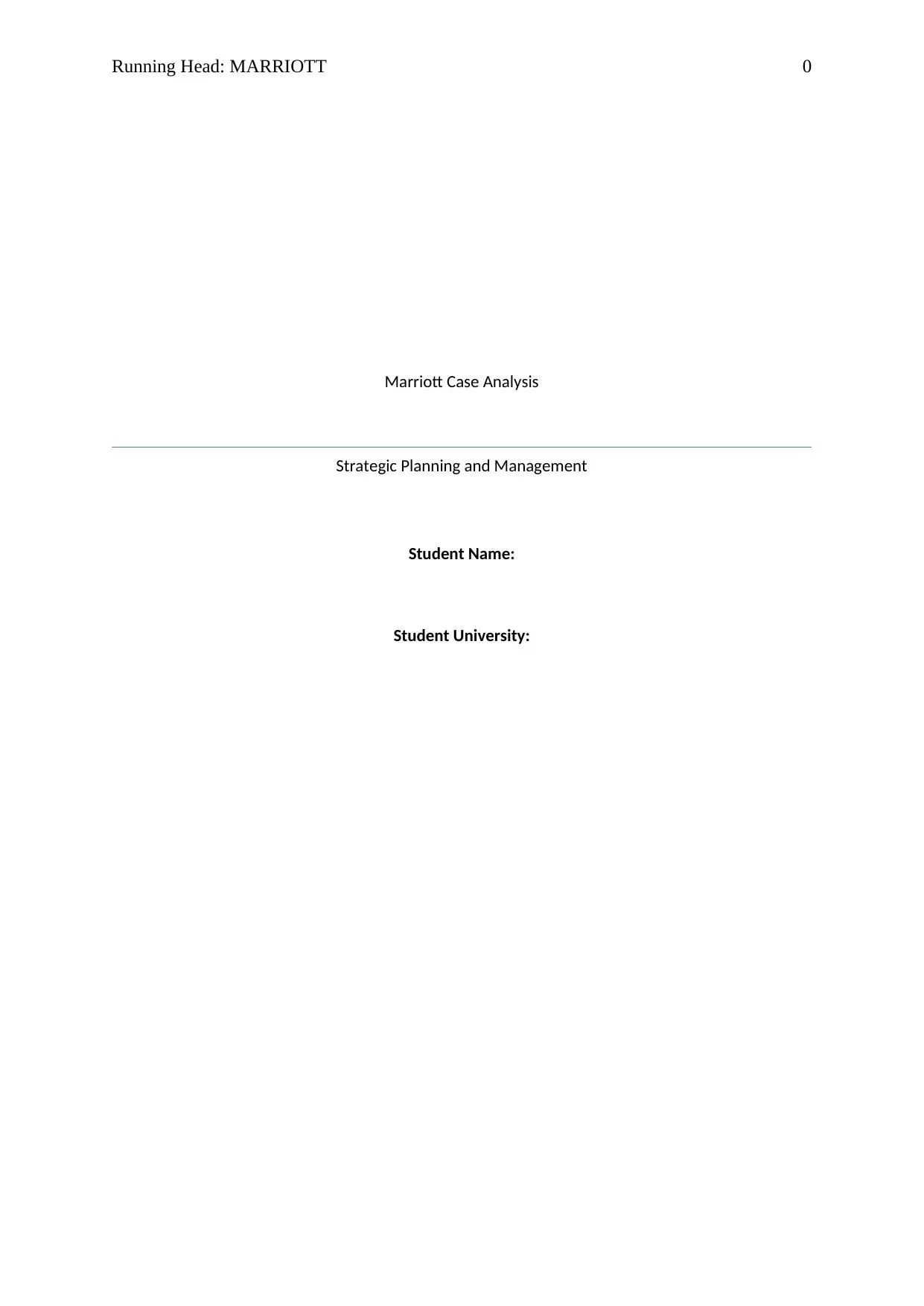
Running Head: MARRIOTT 0
Marriott Case Analysis
Strategic Planning and Management
Student Name:
Student University:
Marriott Case Analysis
Strategic Planning and Management
Student Name:
Student University:
Paraphrase This Document
Need a fresh take? Get an instant paraphrase of this document with our AI Paraphraser
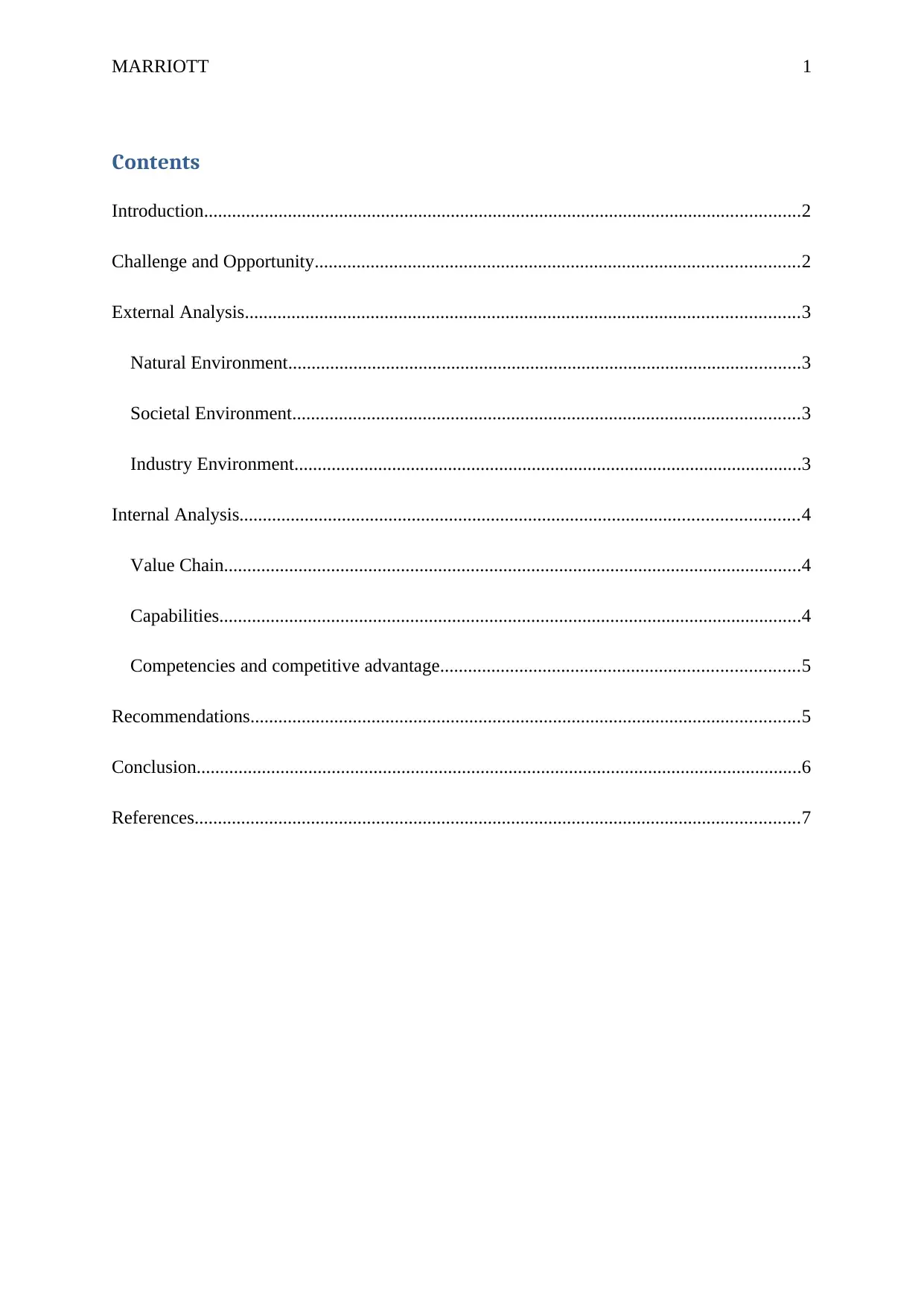
MARRIOTT 1
Contents
Introduction................................................................................................................................2
Challenge and Opportunity........................................................................................................2
External Analysis.......................................................................................................................3
Natural Environment..............................................................................................................3
Societal Environment.............................................................................................................3
Industry Environment.............................................................................................................3
Internal Analysis........................................................................................................................4
Value Chain............................................................................................................................4
Capabilities.............................................................................................................................4
Competencies and competitive advantage.............................................................................5
Recommendations......................................................................................................................5
Conclusion..................................................................................................................................6
References..................................................................................................................................7
Contents
Introduction................................................................................................................................2
Challenge and Opportunity........................................................................................................2
External Analysis.......................................................................................................................3
Natural Environment..............................................................................................................3
Societal Environment.............................................................................................................3
Industry Environment.............................................................................................................3
Internal Analysis........................................................................................................................4
Value Chain............................................................................................................................4
Capabilities.............................................................................................................................4
Competencies and competitive advantage.............................................................................5
Recommendations......................................................................................................................5
Conclusion..................................................................................................................................6
References..................................................................................................................................7
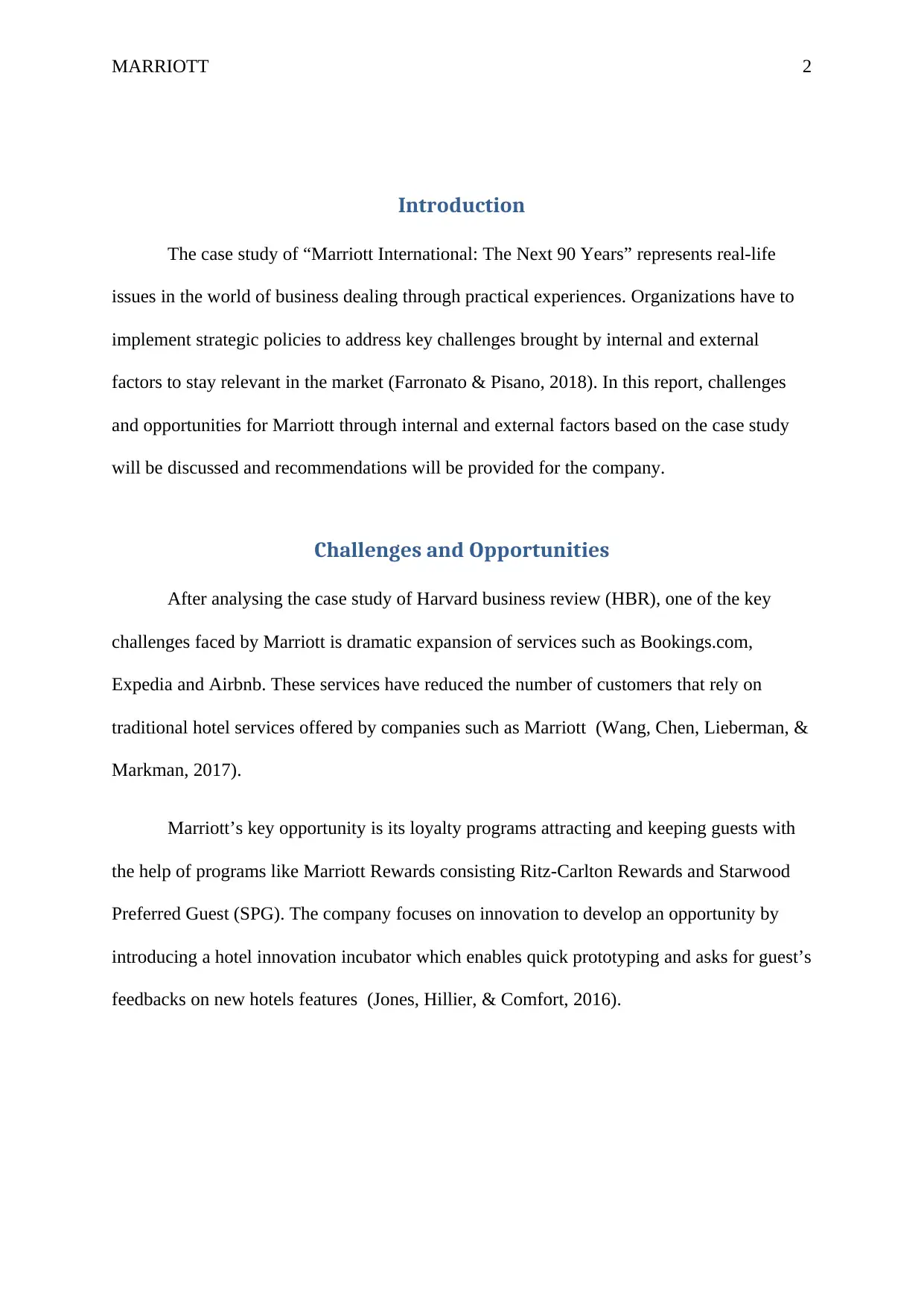
MARRIOTT 2
Introduction
The case study of “Marriott International: The Next 90 Years” represents real-life
issues in the world of business dealing through practical experiences. Organizations have to
implement strategic policies to address key challenges brought by internal and external
factors to stay relevant in the market (Farronato & Pisano, 2018). In this report, challenges
and opportunities for Marriott through internal and external factors based on the case study
will be discussed and recommendations will be provided for the company.
Challenges and Opportunities
After analysing the case study of Harvard business review (HBR), one of the key
challenges faced by Marriott is dramatic expansion of services such as Bookings.com,
Expedia and Airbnb. These services have reduced the number of customers that rely on
traditional hotel services offered by companies such as Marriott (Wang, Chen, Lieberman, &
Markman, 2017).
Marriott’s key opportunity is its loyalty programs attracting and keeping guests with
the help of programs like Marriott Rewards consisting Ritz-Carlton Rewards and Starwood
Preferred Guest (SPG). The company focuses on innovation to develop an opportunity by
introducing a hotel innovation incubator which enables quick prototyping and asks for guest’s
feedbacks on new hotels features (Jones, Hillier, & Comfort, 2016).
Introduction
The case study of “Marriott International: The Next 90 Years” represents real-life
issues in the world of business dealing through practical experiences. Organizations have to
implement strategic policies to address key challenges brought by internal and external
factors to stay relevant in the market (Farronato & Pisano, 2018). In this report, challenges
and opportunities for Marriott through internal and external factors based on the case study
will be discussed and recommendations will be provided for the company.
Challenges and Opportunities
After analysing the case study of Harvard business review (HBR), one of the key
challenges faced by Marriott is dramatic expansion of services such as Bookings.com,
Expedia and Airbnb. These services have reduced the number of customers that rely on
traditional hotel services offered by companies such as Marriott (Wang, Chen, Lieberman, &
Markman, 2017).
Marriott’s key opportunity is its loyalty programs attracting and keeping guests with
the help of programs like Marriott Rewards consisting Ritz-Carlton Rewards and Starwood
Preferred Guest (SPG). The company focuses on innovation to develop an opportunity by
introducing a hotel innovation incubator which enables quick prototyping and asks for guest’s
feedbacks on new hotels features (Jones, Hillier, & Comfort, 2016).
⊘ This is a preview!⊘
Do you want full access?
Subscribe today to unlock all pages.

Trusted by 1+ million students worldwide
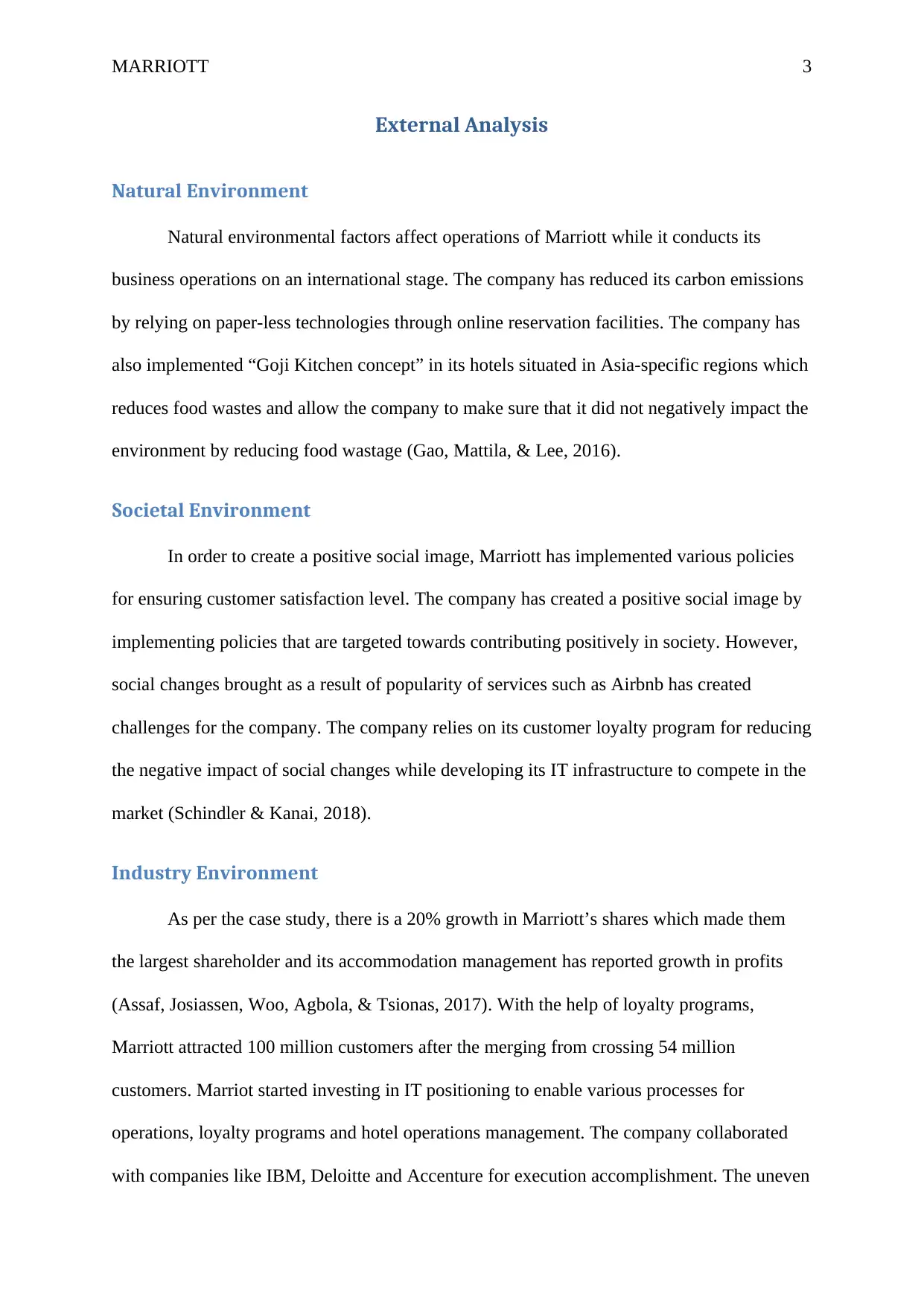
MARRIOTT 3
External Analysis
Natural Environment
Natural environmental factors affect operations of Marriott while it conducts its
business operations on an international stage. The company has reduced its carbon emissions
by relying on paper-less technologies through online reservation facilities. The company has
also implemented “Goji Kitchen concept” in its hotels situated in Asia-specific regions which
reduces food wastes and allow the company to make sure that it did not negatively impact the
environment by reducing food wastage (Gao, Mattila, & Lee, 2016).
Societal Environment
In order to create a positive social image, Marriott has implemented various policies
for ensuring customer satisfaction level. The company has created a positive social image by
implementing policies that are targeted towards contributing positively in society. However,
social changes brought as a result of popularity of services such as Airbnb has created
challenges for the company. The company relies on its customer loyalty program for reducing
the negative impact of social changes while developing its IT infrastructure to compete in the
market (Schindler & Kanai, 2018).
Industry Environment
As per the case study, there is a 20% growth in Marriott’s shares which made them
the largest shareholder and its accommodation management has reported growth in profits
(Assaf, Josiassen, Woo, Agbola, & Tsionas, 2017). With the help of loyalty programs,
Marriott attracted 100 million customers after the merging from crossing 54 million
customers. Marriot started investing in IT positioning to enable various processes for
operations, loyalty programs and hotel operations management. The company collaborated
with companies like IBM, Deloitte and Accenture for execution accomplishment. The uneven
External Analysis
Natural Environment
Natural environmental factors affect operations of Marriott while it conducts its
business operations on an international stage. The company has reduced its carbon emissions
by relying on paper-less technologies through online reservation facilities. The company has
also implemented “Goji Kitchen concept” in its hotels situated in Asia-specific regions which
reduces food wastes and allow the company to make sure that it did not negatively impact the
environment by reducing food wastage (Gao, Mattila, & Lee, 2016).
Societal Environment
In order to create a positive social image, Marriott has implemented various policies
for ensuring customer satisfaction level. The company has created a positive social image by
implementing policies that are targeted towards contributing positively in society. However,
social changes brought as a result of popularity of services such as Airbnb has created
challenges for the company. The company relies on its customer loyalty program for reducing
the negative impact of social changes while developing its IT infrastructure to compete in the
market (Schindler & Kanai, 2018).
Industry Environment
As per the case study, there is a 20% growth in Marriott’s shares which made them
the largest shareholder and its accommodation management has reported growth in profits
(Assaf, Josiassen, Woo, Agbola, & Tsionas, 2017). With the help of loyalty programs,
Marriott attracted 100 million customers after the merging from crossing 54 million
customers. Marriot started investing in IT positioning to enable various processes for
operations, loyalty programs and hotel operations management. The company collaborated
with companies like IBM, Deloitte and Accenture for execution accomplishment. The uneven
Paraphrase This Document
Need a fresh take? Get an instant paraphrase of this document with our AI Paraphraser
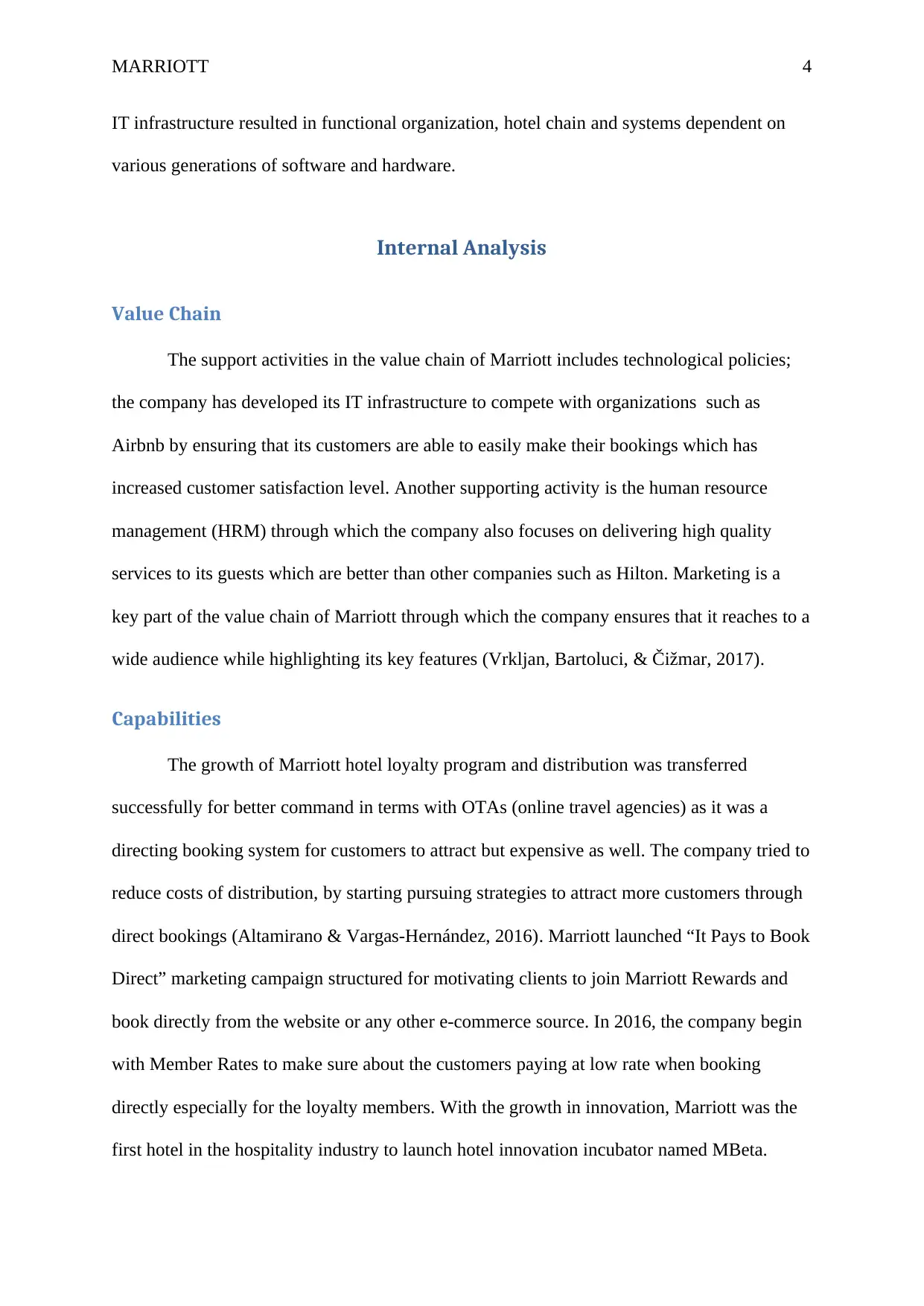
MARRIOTT 4
IT infrastructure resulted in functional organization, hotel chain and systems dependent on
various generations of software and hardware.
Internal Analysis
Value Chain
The support activities in the value chain of Marriott includes technological policies;
the company has developed its IT infrastructure to compete with organizations such as
Airbnb by ensuring that its customers are able to easily make their bookings which has
increased customer satisfaction level. Another supporting activity is the human resource
management (HRM) through which the company also focuses on delivering high quality
services to its guests which are better than other companies such as Hilton. Marketing is a
key part of the value chain of Marriott through which the company ensures that it reaches to a
wide audience while highlighting its key features (Vrkljan, Bartoluci, & Čižmar, 2017).
Capabilities
The growth of Marriott hotel loyalty program and distribution was transferred
successfully for better command in terms with OTAs (online travel agencies) as it was a
directing booking system for customers to attract but expensive as well. The company tried to
reduce costs of distribution, by starting pursuing strategies to attract more customers through
direct bookings (Altamirano & Vargas-Hernández, 2016). Marriott launched “It Pays to Book
Direct” marketing campaign structured for motivating clients to join Marriott Rewards and
book directly from the website or any other e-commerce source. In 2016, the company begin
with Member Rates to make sure about the customers paying at low rate when booking
directly especially for the loyalty members. With the growth in innovation, Marriott was the
first hotel in the hospitality industry to launch hotel innovation incubator named MBeta.
IT infrastructure resulted in functional organization, hotel chain and systems dependent on
various generations of software and hardware.
Internal Analysis
Value Chain
The support activities in the value chain of Marriott includes technological policies;
the company has developed its IT infrastructure to compete with organizations such as
Airbnb by ensuring that its customers are able to easily make their bookings which has
increased customer satisfaction level. Another supporting activity is the human resource
management (HRM) through which the company also focuses on delivering high quality
services to its guests which are better than other companies such as Hilton. Marketing is a
key part of the value chain of Marriott through which the company ensures that it reaches to a
wide audience while highlighting its key features (Vrkljan, Bartoluci, & Čižmar, 2017).
Capabilities
The growth of Marriott hotel loyalty program and distribution was transferred
successfully for better command in terms with OTAs (online travel agencies) as it was a
directing booking system for customers to attract but expensive as well. The company tried to
reduce costs of distribution, by starting pursuing strategies to attract more customers through
direct bookings (Altamirano & Vargas-Hernández, 2016). Marriott launched “It Pays to Book
Direct” marketing campaign structured for motivating clients to join Marriott Rewards and
book directly from the website or any other e-commerce source. In 2016, the company begin
with Member Rates to make sure about the customers paying at low rate when booking
directly especially for the loyalty members. With the growth in innovation, Marriott was the
first hotel in the hospitality industry to launch hotel innovation incubator named MBeta.
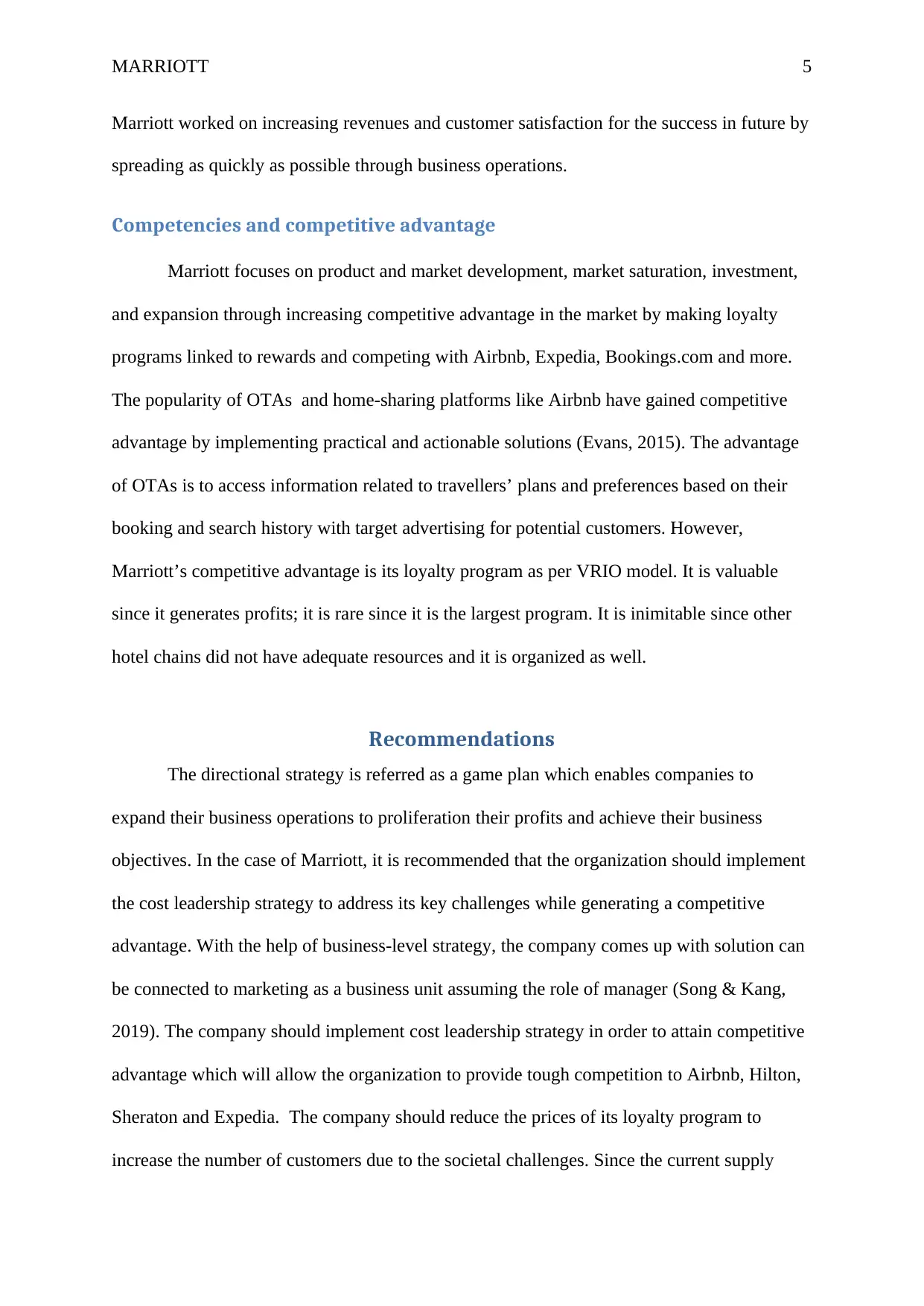
MARRIOTT 5
Marriott worked on increasing revenues and customer satisfaction for the success in future by
spreading as quickly as possible through business operations.
Competencies and competitive advantage
Marriott focuses on product and market development, market saturation, investment,
and expansion through increasing competitive advantage in the market by making loyalty
programs linked to rewards and competing with Airbnb, Expedia, Bookings.com and more.
The popularity of OTAs and home-sharing platforms like Airbnb have gained competitive
advantage by implementing practical and actionable solutions (Evans, 2015). The advantage
of OTAs is to access information related to travellers’ plans and preferences based on their
booking and search history with target advertising for potential customers. However,
Marriott’s competitive advantage is its loyalty program as per VRIO model. It is valuable
since it generates profits; it is rare since it is the largest program. It is inimitable since other
hotel chains did not have adequate resources and it is organized as well.
Recommendations
The directional strategy is referred as a game plan which enables companies to
expand their business operations to proliferation their profits and achieve their business
objectives. In the case of Marriott, it is recommended that the organization should implement
the cost leadership strategy to address its key challenges while generating a competitive
advantage. With the help of business-level strategy, the company comes up with solution can
be connected to marketing as a business unit assuming the role of manager (Song & Kang,
2019). The company should implement cost leadership strategy in order to attain competitive
advantage which will allow the organization to provide tough competition to Airbnb, Hilton,
Sheraton and Expedia. The company should reduce the prices of its loyalty program to
increase the number of customers due to the societal challenges. Since the current supply
Marriott worked on increasing revenues and customer satisfaction for the success in future by
spreading as quickly as possible through business operations.
Competencies and competitive advantage
Marriott focuses on product and market development, market saturation, investment,
and expansion through increasing competitive advantage in the market by making loyalty
programs linked to rewards and competing with Airbnb, Expedia, Bookings.com and more.
The popularity of OTAs and home-sharing platforms like Airbnb have gained competitive
advantage by implementing practical and actionable solutions (Evans, 2015). The advantage
of OTAs is to access information related to travellers’ plans and preferences based on their
booking and search history with target advertising for potential customers. However,
Marriott’s competitive advantage is its loyalty program as per VRIO model. It is valuable
since it generates profits; it is rare since it is the largest program. It is inimitable since other
hotel chains did not have adequate resources and it is organized as well.
Recommendations
The directional strategy is referred as a game plan which enables companies to
expand their business operations to proliferation their profits and achieve their business
objectives. In the case of Marriott, it is recommended that the organization should implement
the cost leadership strategy to address its key challenges while generating a competitive
advantage. With the help of business-level strategy, the company comes up with solution can
be connected to marketing as a business unit assuming the role of manager (Song & Kang,
2019). The company should implement cost leadership strategy in order to attain competitive
advantage which will allow the organization to provide tough competition to Airbnb, Hilton,
Sheraton and Expedia. The company should reduce the prices of its loyalty program to
increase the number of customers due to the societal challenges. Since the current supply
⊘ This is a preview!⊘
Do you want full access?
Subscribe today to unlock all pages.

Trusted by 1+ million students worldwide
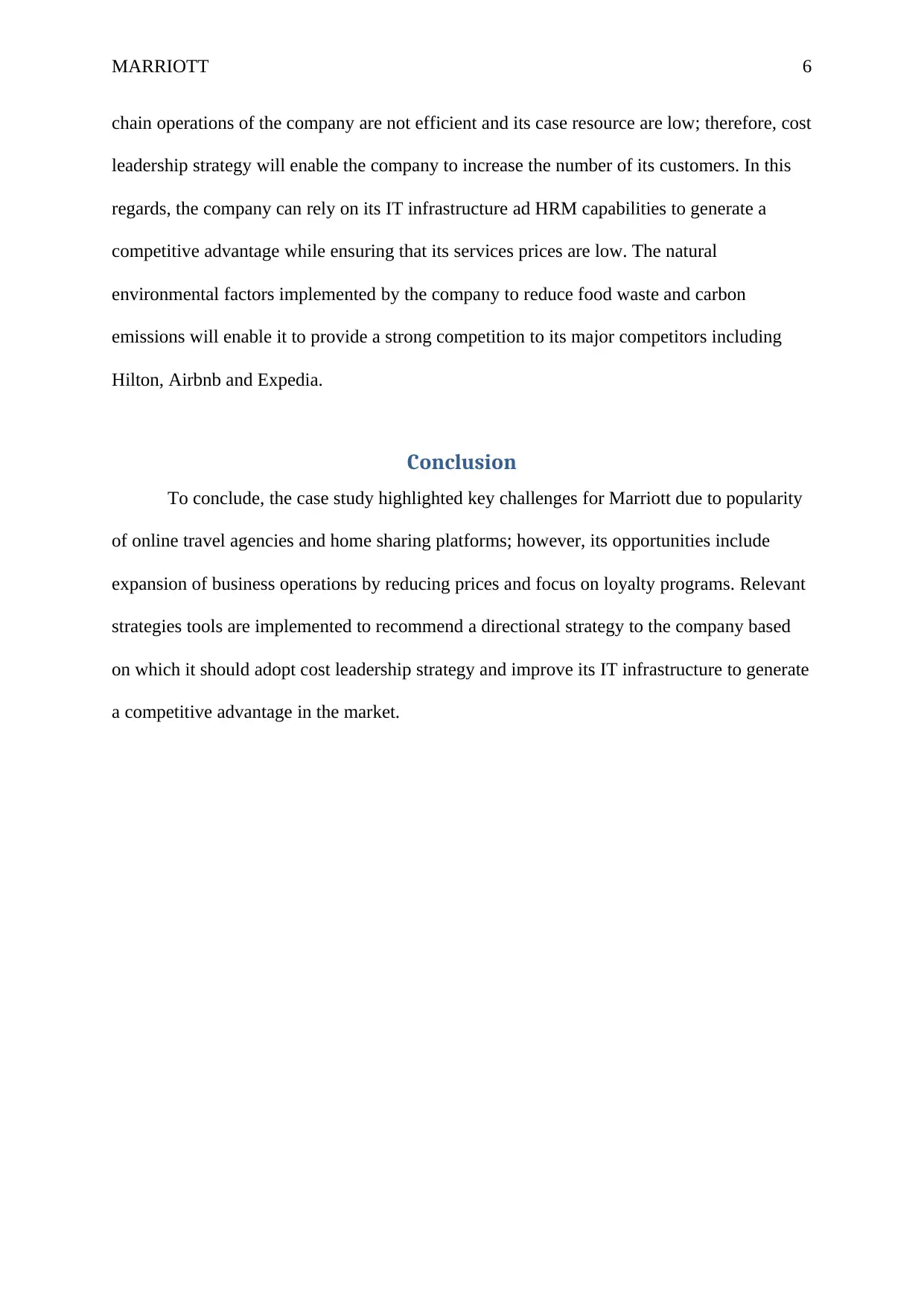
MARRIOTT 6
chain operations of the company are not efficient and its case resource are low; therefore, cost
leadership strategy will enable the company to increase the number of its customers. In this
regards, the company can rely on its IT infrastructure ad HRM capabilities to generate a
competitive advantage while ensuring that its services prices are low. The natural
environmental factors implemented by the company to reduce food waste and carbon
emissions will enable it to provide a strong competition to its major competitors including
Hilton, Airbnb and Expedia.
Conclusion
To conclude, the case study highlighted key challenges for Marriott due to popularity
of online travel agencies and home sharing platforms; however, its opportunities include
expansion of business operations by reducing prices and focus on loyalty programs. Relevant
strategies tools are implemented to recommend a directional strategy to the company based
on which it should adopt cost leadership strategy and improve its IT infrastructure to generate
a competitive advantage in the market.
chain operations of the company are not efficient and its case resource are low; therefore, cost
leadership strategy will enable the company to increase the number of its customers. In this
regards, the company can rely on its IT infrastructure ad HRM capabilities to generate a
competitive advantage while ensuring that its services prices are low. The natural
environmental factors implemented by the company to reduce food waste and carbon
emissions will enable it to provide a strong competition to its major competitors including
Hilton, Airbnb and Expedia.
Conclusion
To conclude, the case study highlighted key challenges for Marriott due to popularity
of online travel agencies and home sharing platforms; however, its opportunities include
expansion of business operations by reducing prices and focus on loyalty programs. Relevant
strategies tools are implemented to recommend a directional strategy to the company based
on which it should adopt cost leadership strategy and improve its IT infrastructure to generate
a competitive advantage in the market.
Paraphrase This Document
Need a fresh take? Get an instant paraphrase of this document with our AI Paraphraser
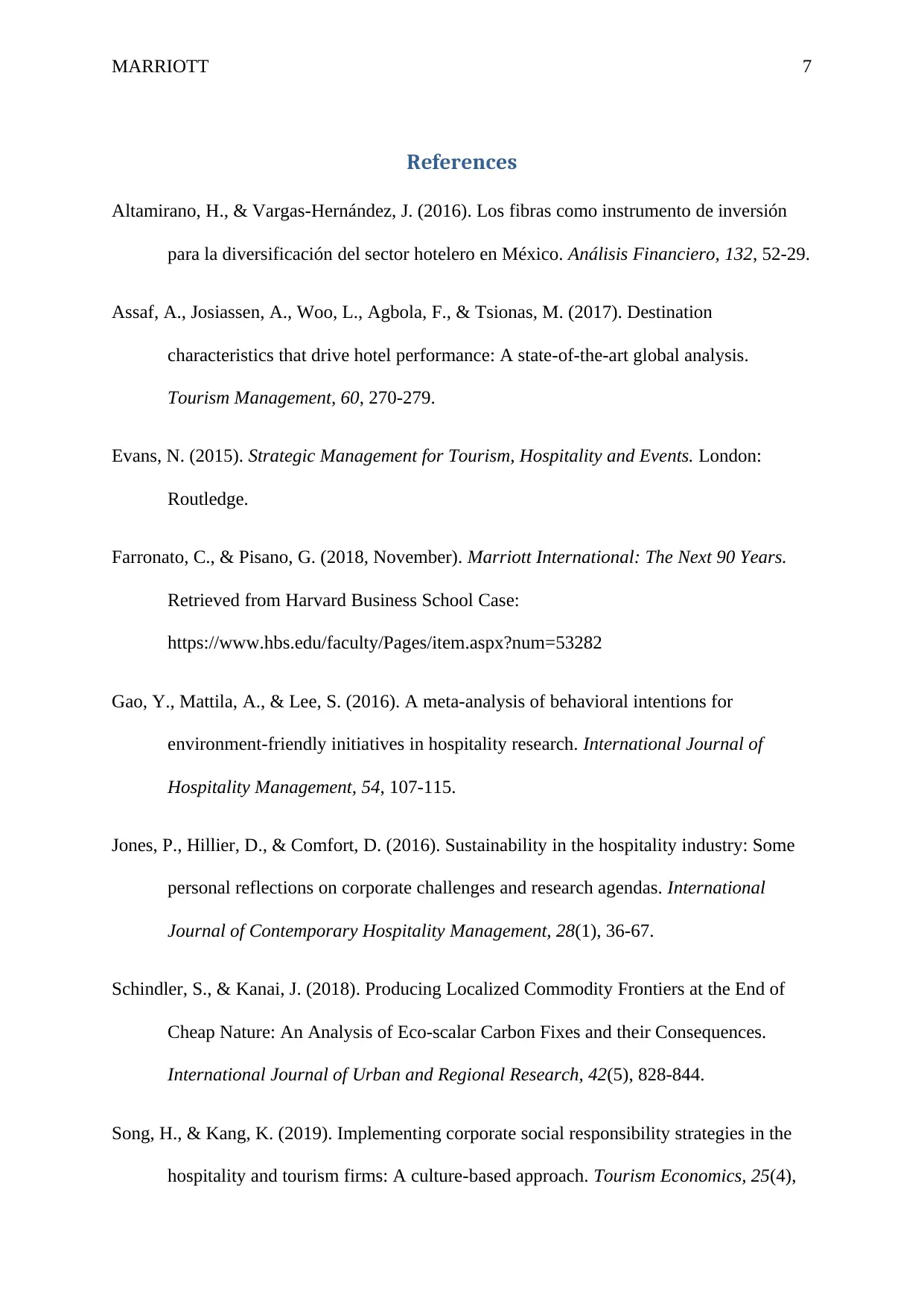
MARRIOTT 7
References
Altamirano, H., & Vargas-Hernández, J. (2016). Los fibras como instrumento de inversión
para la diversificación del sector hotelero en México. Análisis Financiero, 132, 52-29.
Assaf, A., Josiassen, A., Woo, L., Agbola, F., & Tsionas, M. (2017). Destination
characteristics that drive hotel performance: A state-of-the-art global analysis.
Tourism Management, 60, 270-279.
Evans, N. (2015). Strategic Management for Tourism, Hospitality and Events. London:
Routledge.
Farronato, C., & Pisano, G. (2018, November). Marriott International: The Next 90 Years.
Retrieved from Harvard Business School Case:
https://www.hbs.edu/faculty/Pages/item.aspx?num=53282
Gao, Y., Mattila, A., & Lee, S. (2016). A meta-analysis of behavioral intentions for
environment-friendly initiatives in hospitality research. International Journal of
Hospitality Management, 54, 107-115.
Jones, P., Hillier, D., & Comfort, D. (2016). Sustainability in the hospitality industry: Some
personal reflections on corporate challenges and research agendas. International
Journal of Contemporary Hospitality Management, 28(1), 36-67.
Schindler, S., & Kanai, J. (2018). Producing Localized Commodity Frontiers at the End of
Cheap Nature: An Analysis of Eco‐scalar Carbon Fixes and their Consequences.
International Journal of Urban and Regional Research, 42(5), 828-844.
Song, H., & Kang, K. (2019). Implementing corporate social responsibility strategies in the
hospitality and tourism firms: A culture-based approach. Tourism Economics, 25(4),
References
Altamirano, H., & Vargas-Hernández, J. (2016). Los fibras como instrumento de inversión
para la diversificación del sector hotelero en México. Análisis Financiero, 132, 52-29.
Assaf, A., Josiassen, A., Woo, L., Agbola, F., & Tsionas, M. (2017). Destination
characteristics that drive hotel performance: A state-of-the-art global analysis.
Tourism Management, 60, 270-279.
Evans, N. (2015). Strategic Management for Tourism, Hospitality and Events. London:
Routledge.
Farronato, C., & Pisano, G. (2018, November). Marriott International: The Next 90 Years.
Retrieved from Harvard Business School Case:
https://www.hbs.edu/faculty/Pages/item.aspx?num=53282
Gao, Y., Mattila, A., & Lee, S. (2016). A meta-analysis of behavioral intentions for
environment-friendly initiatives in hospitality research. International Journal of
Hospitality Management, 54, 107-115.
Jones, P., Hillier, D., & Comfort, D. (2016). Sustainability in the hospitality industry: Some
personal reflections on corporate challenges and research agendas. International
Journal of Contemporary Hospitality Management, 28(1), 36-67.
Schindler, S., & Kanai, J. (2018). Producing Localized Commodity Frontiers at the End of
Cheap Nature: An Analysis of Eco‐scalar Carbon Fixes and their Consequences.
International Journal of Urban and Regional Research, 42(5), 828-844.
Song, H., & Kang, K. (2019). Implementing corporate social responsibility strategies in the
hospitality and tourism firms: A culture-based approach. Tourism Economics, 25(4),
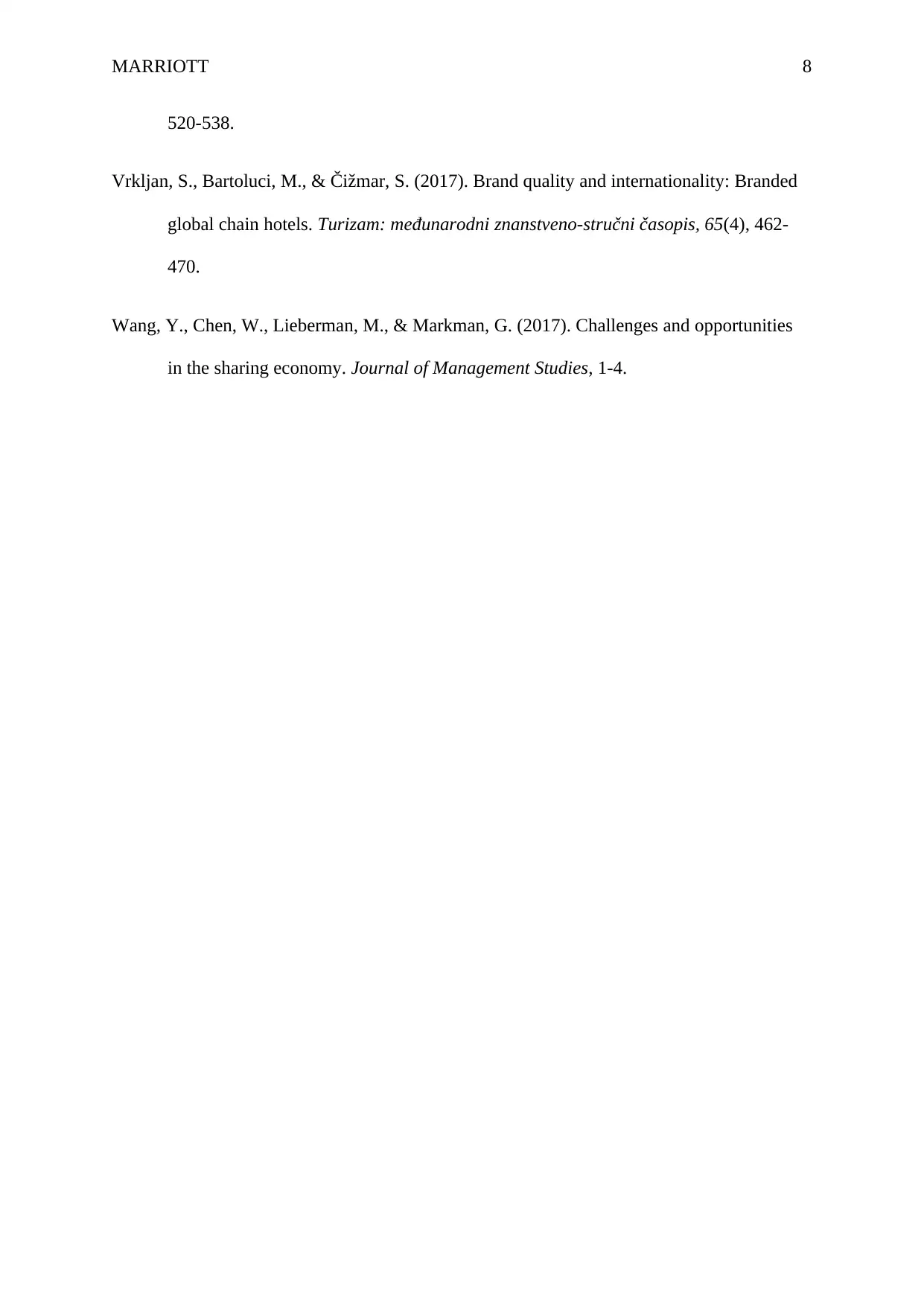
MARRIOTT 8
520-538.
Vrkljan, S., Bartoluci, M., & Čižmar, S. (2017). Brand quality and internationality: Branded
global chain hotels. Turizam: međunarodni znanstveno-stručni časopis, 65(4), 462-
470.
Wang, Y., Chen, W., Lieberman, M., & Markman, G. (2017). Challenges and opportunities
in the sharing economy. Journal of Management Studies, 1-4.
520-538.
Vrkljan, S., Bartoluci, M., & Čižmar, S. (2017). Brand quality and internationality: Branded
global chain hotels. Turizam: međunarodni znanstveno-stručni časopis, 65(4), 462-
470.
Wang, Y., Chen, W., Lieberman, M., & Markman, G. (2017). Challenges and opportunities
in the sharing economy. Journal of Management Studies, 1-4.
⊘ This is a preview!⊘
Do you want full access?
Subscribe today to unlock all pages.

Trusted by 1+ million students worldwide
1 out of 9
Related Documents
Your All-in-One AI-Powered Toolkit for Academic Success.
+13062052269
info@desklib.com
Available 24*7 on WhatsApp / Email
![[object Object]](/_next/static/media/star-bottom.7253800d.svg)
Unlock your academic potential
Copyright © 2020–2025 A2Z Services. All Rights Reserved. Developed and managed by ZUCOL.





